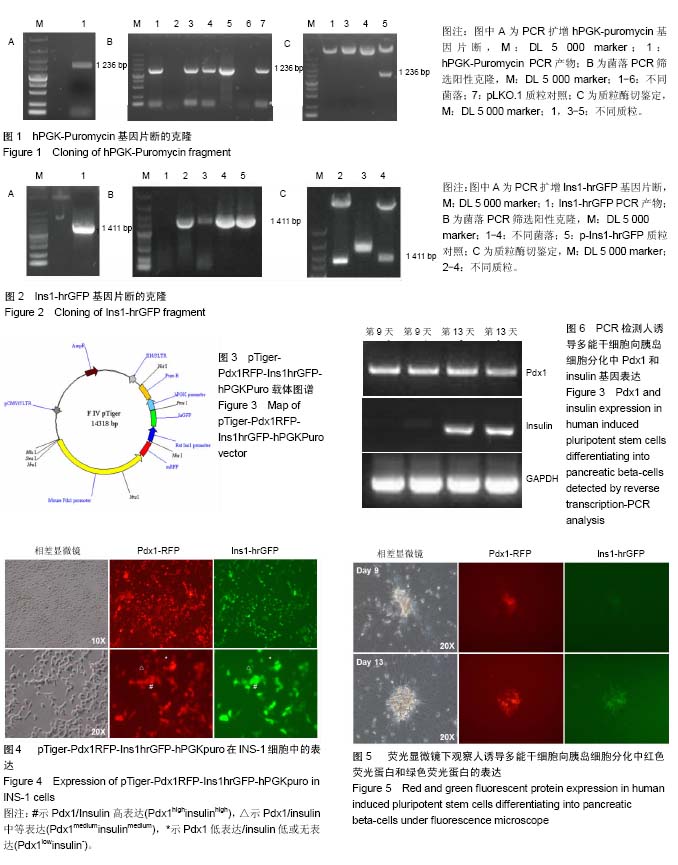| [1] Xu Y, Wang L, He J, et al. Prevalence and control of diabetes in Chinese adults. JAMA. 2013;310(9):948-959.[2] Atkinson MA, Eisenbarth GS. Type 1 diabetes: new perspectives on disease pathogenesis and treatment. Lancet. 2001;358(9277):221-229. [3] Sachs DH, Bonner-Weir S. New islets from old. Nat Med. 2000;6(3):250-251.[4] Serup P, Madsen OD, Mandrup-Poulsen T. Islet and stem cell transplantation for treating diabetes. BMJ. 2001;322(7277):29-32.[5] Xie M, Ye H, Wang H, et al. β-cell-mimetic designer cells provide closed-loop glycemic control. Science. 2016;354 (6317):1296-1301.[6] Lumelsky N, Blondel O, Laeng P, et al. Differentiation of embryonic stem cells to insulin-secreting structures similar to pancreatic islets. Science. 2001;292(5520):1389-1394.[7] Soria B, Roche E, Berná G, et al. Insulin-secreting cells derived from embryonic stem cells normalize glycemia in streptozotocin-induced diabetic mice. Diabetes. 2000;49(2): 157-162.[8] Assady S, Maor G, Amit M, et al. Insulin production by human embryonic stem cells. Diabetes. 2001;50(8):1691-1697.[9] Moritoh Y, Yamato E, Yasui Y, et al. Analysis of insulin-producing cells during in vitro differentiation from feeder-free embryonic stem cells. Diabetes. 2003;52(5):1163-1168.[10] Lester LB, Kuo HC, Andrews L, et al. Directed differentiation of rhesus monkey ES cells into pancreatic cell phenotypes. Reprod Biol Endocrinol. 2004;2:42.[11] León-Quinto T, Jones J, Skoudy A, et al. In vitro directed differentiation of mouse embryonic stem cells into insulin-producing cells. Diabetologia. 2004;47(8):1442-1451.[12] D'Amour KA, Bang AG, Eliazer S, et al. Production of pancreatic hormone-expressing endocrine cells from human embryonic stem cells. Nat Biotechnol. 2006;24(11): 1392-1401.[13] Kroon E, Martinson LA, Kadoya K, et al. Pancreatic endoderm derived from human embryonic stem cells generates glucose-responsive insulin-secreting cells in vivo. Nat Biotechnol. 2008;26(4):443-452.[14] Maehr R, Chen S, Snitow M, et al. Generation of pluripotent stem cells from patients with type 1 diabetes. Proc Natl Acad Sci U S A. 2009;106(37):15768-15773.[15] Pagliuca FW, Millman JR, Gürtler M, et al. Generation of functional human pancreatic β cells in vitro. Cell. 2014; 159(2): 428-439.[16] Takahashi K, Yamanaka S. Induction of pluripotent stem cells from mouse embryonic and adult fibroblast cultures by defined factors. Cell. 2006;126(4):663-676.[17] Yu J, Vodyanik MA, Smuga-Otto K, et al. Induced pluripotent stem cell lines derived from human somatic cells. Science. 2007;318(5858):1917-1920.[18] Kim JB, Greber B, Araúzo-Bravo MJ, et al. Direct reprogramming of human neural stem cells by OCT4. Nature. 2009;461(7264):649-653.[19] Moriguchi H, Chung RT, Mihara M, et al. Generation of human induced pluripotent stem cells from liver progenitor cells by only small molecules. Hepatology. 2010;52(3):1169.[20] Giorgetti A, Montserrat N, Rodriguez-Piza I, et al. Generation of induced pluripotent stem cells from human cord blood cells with only two factors: Oct4 and Sox2. Nat Protoc. 2010;5(4): 811-820.[21] Shaer A, Azarpira N, Karimi MH. Differentiation of human induced pluripotent stem cells into insulin-like cell clusters with miR-186 and miR-375 by using chemical transfection. Appl Biochem Biotechnol. 2014;174(1):242-258.[22] Prasain N, Lee MR, Vemula S, et al. Differentiation of human pluripotent stem cells to cells similar to cord-blood endothelial colony-forming cells. Nat Biotechnol. 2014;32(11):1151-1157.[23] Diekmann U, Lenzen S, Naujok O. A reliable and efficient protocol for human pluripotent stem cell differentiation into the definitive endoderm based on dispersed single cells. Stem Cells Dev. 2015;24(2):190-204.[24] Toyoda T, Mae S, Tanaka H, et al. Cell aggregation optimizes the differentiation of human ESCs and iPSCs into pancreatic bud-like progenitor cells. Stem Cell Res. 2015;14(2):185-197.[25] Ikonomou L, Kotton DN. Derivation of Endodermal Progenitors From Pluripotent Stem Cells. J Cell Physiol. 2015; 230(2):246-258.[26] Shaer A, Azarpira N, Vahdati A, et al. Differentiation of human-induced pluripotent stem cells into insulin-producing clusters. Exp Clin Transplant. 2015;13(1):68-75.[27] Mauda-Havakuk M, Litichever N, Chernichovski E, et al. Ectopic PDX-1 expression directly reprograms human keratinocytes along pancreatic insulin-producing cells fate. PLoS One. 2011;6(10):e26298.[28] Zhou Q, Brown J, Kanarek A, et al. In vivo reprogramming of adult pancreatic exocrine cells to beta-cells. Nature. 2008; 455(7213):627-632.[29] Akinci E, Banga A, Greder LV, et al. Reprogramming of pancreatic exocrine cells towards a beta (β) cell character using Pdx1, Ngn3 and MafA. Biochem J. 2012;442(3): 539-550.[30] Shi Y, Hou L, Tang F, et al. Inducing embryonic stem cells to differentiate into pancreatic beta cells by a novel three-step approach with activin A and all-trans retinoic acid. Stem Cells. 2005;23(5):656-662.[31] Kunisada Y, Tsubooka-Yamazoe N, Shoji M, et al. Small molecules induce efficient differentiation into insulin-producing cells from human induced pluripotent stem cells. Stem Cell Res. 2012;8(2):274-284.[32] Loh KM, Ang LT, Zhang J, et al. Efficient endoderm induction from human pluripotent stem cells by logically directing signals controlling lineage bifurcations. Cell Stem Cell. 2014; 14(2):237-252.[33] Rezania A, Bruin JE, Arora P, et al. Reversal of diabetes with insulin-producing cells derived in vitro from human pluripotent stem cells. Nat Biotechnol. 2014;32(11):1121-1133.[34] Wang Q, Wang H, Sun Y, et al. The reprogrammed pancreatic progenitor-like intermediate state of hepatic cells is more susceptible to pancreatic beta cell differentiation. J Cell Sci. 2013;126(Pt 16):3638-3648.[35] Murtaugh LC, Melton DA. Genes, signals, and lineages in pancreas development. Annu Rev Cell Dev Biol. 2003;19: 71-89. [36] Jensen J. Gene regulatory factors in pancreatic development. Dev Dyn. 2004;229(1):176-200.[37] Szabat M, Luciani DS, Piret JM, et al. Maturation of adult beta-cells revealed using a Pdx1/insulin dual-reporter lentivirus. Endocrinology. 2009;150(4):1627-1635. |
.jpg) 文题释义:
Pdx1(pancreatic and duodenal homeobox1):即胰十二指肠同源盒1,又称胰岛素启动因子1(IPF-1)。Pdx1在胰腺的发育(包括胰岛β细胞的成熟)以及十二指肠的分化中具有重要作用。胚胎发育过程中Pdx1 首先表达在前肠后部的内胚层,随后表达Pdx1的内皮细胞发育成胰芽,进而发育成胰腺包括外分泌部、内分泌部以及导管细胞。研究表明Pdx1纯合缺失小鼠可以出现早期胰芽发育受阻,导致胰腺发育不全,出生后不久即死于高血糖血症。
诱导多能干细胞:是由日本学者Takahashi和Yamanaka首先建立的。体外采用4个关键性因子将小鼠成纤维细胞重编程为胚胎干细胞样细胞。诱导多能干细胞避免了胚胎干细胞所遇到的伦理道德问题,而且由于来源自体细胞,因此不存在自身移植免疫排斥反应。诱导多能干细胞具有自我更新和多向分化的潜能,在再生医学、疾病模型和药物筛选中具有重要作用。
文题释义:
Pdx1(pancreatic and duodenal homeobox1):即胰十二指肠同源盒1,又称胰岛素启动因子1(IPF-1)。Pdx1在胰腺的发育(包括胰岛β细胞的成熟)以及十二指肠的分化中具有重要作用。胚胎发育过程中Pdx1 首先表达在前肠后部的内胚层,随后表达Pdx1的内皮细胞发育成胰芽,进而发育成胰腺包括外分泌部、内分泌部以及导管细胞。研究表明Pdx1纯合缺失小鼠可以出现早期胰芽发育受阻,导致胰腺发育不全,出生后不久即死于高血糖血症。
诱导多能干细胞:是由日本学者Takahashi和Yamanaka首先建立的。体外采用4个关键性因子将小鼠成纤维细胞重编程为胚胎干细胞样细胞。诱导多能干细胞避免了胚胎干细胞所遇到的伦理道德问题,而且由于来源自体细胞,因此不存在自身移植免疫排斥反应。诱导多能干细胞具有自我更新和多向分化的潜能,在再生医学、疾病模型和药物筛选中具有重要作用。.jpg) 文题释义:
Pdx1(pancreatic and duodenal homeobox1):即胰十二指肠同源盒1,又称胰岛素启动因子1(IPF-1)。Pdx1在胰腺的发育(包括胰岛β细胞的成熟)以及十二指肠的分化中具有重要作用。胚胎发育过程中Pdx1 首先表达在前肠后部的内胚层,随后表达Pdx1的内皮细胞发育成胰芽,进而发育成胰腺包括外分泌部、内分泌部以及导管细胞。研究表明Pdx1纯合缺失小鼠可以出现早期胰芽发育受阻,导致胰腺发育不全,出生后不久即死于高血糖血症。
诱导多能干细胞:是由日本学者Takahashi和Yamanaka首先建立的。体外采用4个关键性因子将小鼠成纤维细胞重编程为胚胎干细胞样细胞。诱导多能干细胞避免了胚胎干细胞所遇到的伦理道德问题,而且由于来源自体细胞,因此不存在自身移植免疫排斥反应。诱导多能干细胞具有自我更新和多向分化的潜能,在再生医学、疾病模型和药物筛选中具有重要作用。
文题释义:
Pdx1(pancreatic and duodenal homeobox1):即胰十二指肠同源盒1,又称胰岛素启动因子1(IPF-1)。Pdx1在胰腺的发育(包括胰岛β细胞的成熟)以及十二指肠的分化中具有重要作用。胚胎发育过程中Pdx1 首先表达在前肠后部的内胚层,随后表达Pdx1的内皮细胞发育成胰芽,进而发育成胰腺包括外分泌部、内分泌部以及导管细胞。研究表明Pdx1纯合缺失小鼠可以出现早期胰芽发育受阻,导致胰腺发育不全,出生后不久即死于高血糖血症。
诱导多能干细胞:是由日本学者Takahashi和Yamanaka首先建立的。体外采用4个关键性因子将小鼠成纤维细胞重编程为胚胎干细胞样细胞。诱导多能干细胞避免了胚胎干细胞所遇到的伦理道德问题,而且由于来源自体细胞,因此不存在自身移植免疫排斥反应。诱导多能干细胞具有自我更新和多向分化的潜能,在再生医学、疾病模型和药物筛选中具有重要作用。
.jpg) 文题释义:
Pdx1(pancreatic and duodenal homeobox1):即胰十二指肠同源盒1,又称胰岛素启动因子1(IPF-1)。Pdx1在胰腺的发育(包括胰岛β细胞的成熟)以及十二指肠的分化中具有重要作用。胚胎发育过程中Pdx1 首先表达在前肠后部的内胚层,随后表达Pdx1的内皮细胞发育成胰芽,进而发育成胰腺包括外分泌部、内分泌部以及导管细胞。研究表明Pdx1纯合缺失小鼠可以出现早期胰芽发育受阻,导致胰腺发育不全,出生后不久即死于高血糖血症。
诱导多能干细胞:是由日本学者Takahashi和Yamanaka首先建立的。体外采用4个关键性因子将小鼠成纤维细胞重编程为胚胎干细胞样细胞。诱导多能干细胞避免了胚胎干细胞所遇到的伦理道德问题,而且由于来源自体细胞,因此不存在自身移植免疫排斥反应。诱导多能干细胞具有自我更新和多向分化的潜能,在再生医学、疾病模型和药物筛选中具有重要作用。
文题释义:
Pdx1(pancreatic and duodenal homeobox1):即胰十二指肠同源盒1,又称胰岛素启动因子1(IPF-1)。Pdx1在胰腺的发育(包括胰岛β细胞的成熟)以及十二指肠的分化中具有重要作用。胚胎发育过程中Pdx1 首先表达在前肠后部的内胚层,随后表达Pdx1的内皮细胞发育成胰芽,进而发育成胰腺包括外分泌部、内分泌部以及导管细胞。研究表明Pdx1纯合缺失小鼠可以出现早期胰芽发育受阻,导致胰腺发育不全,出生后不久即死于高血糖血症。
诱导多能干细胞:是由日本学者Takahashi和Yamanaka首先建立的。体外采用4个关键性因子将小鼠成纤维细胞重编程为胚胎干细胞样细胞。诱导多能干细胞避免了胚胎干细胞所遇到的伦理道德问题,而且由于来源自体细胞,因此不存在自身移植免疫排斥反应。诱导多能干细胞具有自我更新和多向分化的潜能,在再生医学、疾病模型和药物筛选中具有重要作用。